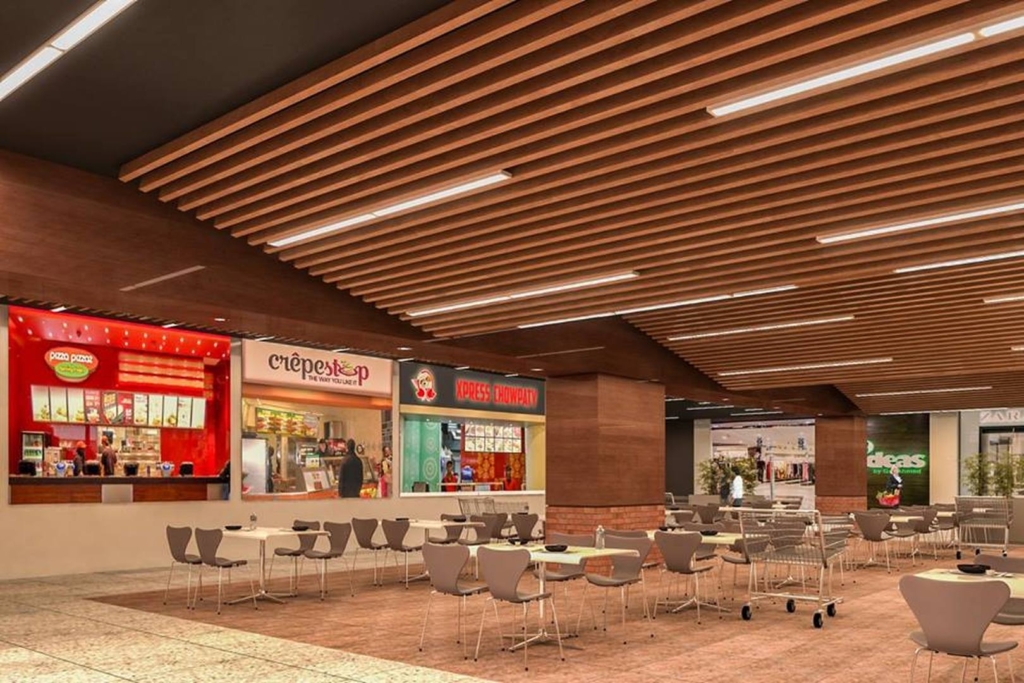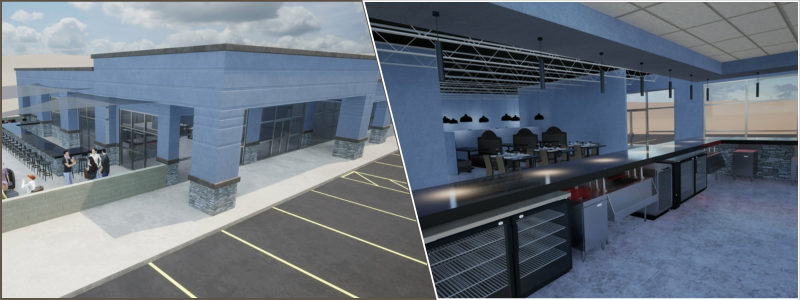Let’s set one thing straight: there isn’t any difference in the process and production of commercial and residential architectural services in the sense that both aim to create a photorealistic visualization of a building, including its interior, exterior, and the surrounding environment. The only distinction between the two is the object to be rendered. Commercial rendering deals with non-residential buildings like office centers, shopping malls, universities, restaurants, hotels, airports, sports stadiums, industrial facilities, etc.
Cad Crowd is an industry leader in providing outsourced 3D rendering services for architectural and engineering companies. This article will explore 3D rendering for commercial spaces and its associated costs.

Rates for commercial 3D rendering
The following rates apply to 3D rendering services for commercial buildings in various project scenarios and pricing structures.
| Pricing per image | |||
| Rendering scenario | Provider | ||
| Freelancers | Small to mid-sized businesses | Large design firms | |
| Exterior | $550 – $2500 | $1100 – $3500 | $2500 – $5500 |
| Interior | $750 – $3000 | $1500 – $5000 | $3000 – $10000 |
| Exterior and interior | $1500 – $5000 | $3000 – $10000 | $8000 – $30000 |
Note: there isn’t a clear-cut price range for every service because it all depends on the project’s specific details and the experience level of the render artist or firm handling the task. An experienced freelancer with a reputable portfolio may charge higher than a mid-sized design firm for the same rendering work.
| 3D rendering service rates per hour | |||
| Experience levels (in Years) | Provider | ||
| Freelancers | Small to mid-sized businesses | Large design firms | |
| 0 – 4 | $30 – $60 | $50 – $80 | $70 – $110 |
| 5 – 10 | $50 – $80 | $60 – $120 | $90 – $140 |
| 10 or more | $110 – $140 | $130 – $180 | $160 – $225 |
Note: to ensure good quality, an entry-level render artist should be tasked only with simple work such as exterior silo rendering where the building is placed against a plain background. Senior render artists can handle and manage complex projects that require advanced techniques, extensive details, and artistic touches.
| 3D Rendering Service Rates Per Square Foot | |||
| Rendering complexity | Provider | ||
| Freelancers | Small to mid-sized businesses | Large design firms | |
| Basic | $1.50 – $3.50 | $3.50 – $6.50 | $7.00 – $10.00 |
| Advanced | $2.50 – $6.50 | $5.00 – $8.50 | $9.00 – $12.50 |
| Complex | $5.50 – $8.50 | $7.50 – $13.00 | $12.00 – $20.00 |
Note: the pricing structure is best when you only have to render a small area to save cost. Consider the number of details you expect as well because the final price might come as a surprise unless you know exactly the amount of work involved in getting the render done.
We’re talking only about static rendering here with Full HD (1920x1080p) resolution at a 16:9 ratio as the minimum viable option for online use. 2K is becoming the new standard, and anything higher than 4K can be an overkill for most purposes. Let’s not forget that a 4K visualization requires at least twice as much as Full HD rendering professionals.
For print purposes, 300 DPI should be more than acceptable for magazines, brochures, and newspaper pages. In the case of billboards, due to the sheer size of the canvas and long viewing distance, you can afford to go lower than 150 DPI without losing quality.
What affects the cost of commercial 3D rendering
While a universally agreed-upon formula to determine the cost of commercial 3D rendering services doesn’t exist, there are several factors that directly correlate with how companies calculate their prices.

Project scenarios
Architectural 3D rendering comes in three major types: exterior, interior, and both of them. The main differences among them mainly concern size, level of detail, and number of visible objects in the frame. As far as commercial buildings are concerned, exterior rendering is likely the most affordable and the most common of the three. An exterior rendering often features a variety of environmental elements in addition to the building’s exterior itself, but the process doesn’t actually take as much level of creativity as interior visualization does.
A render artist can only do so much to generate realistic colors for the clouds, unique shapes for the trees, imagery of the moon, hues of water, piles of snow, and so on. However, the artist can be playful with the composition. Some might say imagination is the limit, although this is actually counterproductive because architectural rendering aims to resemble reality as closely as possible.
On the other hand, expert interior rendering can be as complex as it can get thanks to the limitless options for furniture design, room layout, types of light sources (natural or artificial) and placement, wall colors, flooring, and tiny yet important details like crown molding, upholstery textures, and all sorts of decorative pieces. Most (if not all) of those objects, especially when built as custom products, require a lot more modeling work compared to natural objects.
Complexity
A 3D rendering page of a typical house living room is, of course, much less complex than that of a business center lobby. In fact, the former often only includes the interior part of the building, whereas the latter usually showcases the view of the outside area as well; this is to indicate that the building is open to public access, so it needs to show people walking on the sidewalks nearby, street signs, parked cars, and sometimes a glance at adjacent buildings too. The same thing applies to cooking stations at a restaurant, which are almost always more complex than a typical home kitchen.
Complexity refers not only to the number of objects visible in the frame but also to the camera positioning or viewing angle of the image. For aerial rendering services, an aerial shot (or a zoomed-out view) has more visible objects, albeit smaller, in the frame than an eye-level angle, so it’s more expensive. A close-up view doesn’t cover a lot of objects, but it might be used to highlight specific details to serve as focal points, such as a fountain, a statue, an entrance, or unique architectural styles. Sometimes, an eye-level exterior rendering omits the background objects entirely, so the image is presented on a blank page to avoid distraction. It’s not realistic, but it allows viewers to focus solely on the building.
Modern CGI technology also offers interactive 3D rendering, where you can rotate the image to see the building at eye level from various angles. Interactive rendering like this cannot be printed on paper and is only usable as a digital file or a webpage element.

Level of details
Let’s take the exterior renderings of a skyscraper and a football stadium as examples. A lot of skyscrapers use a combination of concrete and glass to build the external walls; there might be some variations in terms of geometric shape, main entrances on the floor level, several decorative touches (such as gargoyles), and unique structures at the top. Most skyscrapers are rectangular, although there are some notable oddly-shaped buildings as well. An exterior rendering from an architectural design firm of a skyscraper doesn’t usually offer detailed imagery due to the monumental size of the building – you need to position the viewing angle at quite a distance from the object to see it as a whole in one frame.
You can probably say the same thing about large stadiums, but they’re admittedly more playful when it comes to architectural style. Unlike the typical rendering of a skyscraper that barely shows anything about the interior, photorealistic imagery of a football stadium cannot afford to omit details like the pitch, the stands, the lighting, and the skyboxes. And if it’s an open-roof stadium, it’s just impossible to exclude those elements.
A skyscraper is most likely pictured as a vertically imposing structure with columns and rows of window glass in the walls, whereas a football stadium has a much larger variety of objects, each with its own tiny details to highlight. Due to the differences in the expected level of detail, you can expect to spend more on the latter.
Page count
Every page is for one rendering only. A commercial building is a massive undertaking, both in planning and the actual construction work. A single rendering page simply won’t be enough to capture all the details you want to showcase. Having only one exterior rendering might be enough, but you need page after page of rendering to visualize the interior. Even if the commercial building is a mostly empty warehouse, chances are you want to highlight the flooring, the roof structure, the massive industrial-grade door, etc.
Some render artists offer one revision free of charge as long as the revised portion doesn’t exceed a specific percentage of the original work. For instance, free revision is only available when the modification amounts to no more than 10% of the submitted document; anything more will count as a new page and an additional fee.
Timeframe
The actual rendering time of an architectural visualization service doesn’t take that long, thanks to modern cloud-based rendering farms. But the early steps of drafting, modeling, and lighting setups might take a few days for a commercial rendering – and that’s assuming the project is handled by a relatively large design firm with multiple artists working on the same visualization. A one-person operation will need more time to finish the same job. Let’s not forget that the image still needs a few post-processing touches after the rendering is complete. Like all services, companies usually offer standard pricing for non-expedited projects and premium rates for rush jobs.
Commercial 3D rendering with Cad Crowd
All sorts of rendering tasks fall under the CAD (computer-aided design) category. It doesn’t matter if you need exterior or interior renderings (or both of them) in a project, Cad Crowd is an industry-leading service that helps you get in touch with some of the world’s most qualified professionals for commercial 3D rendering jobs. Every single one of our render artists has been properly vetted to the highest standard to ensure quality and value for money.
Reach out to Cad Crowd any day of the week now for your free quote, and have your commercial 3D rendering projects done by the experts in the most efficient way possible.
